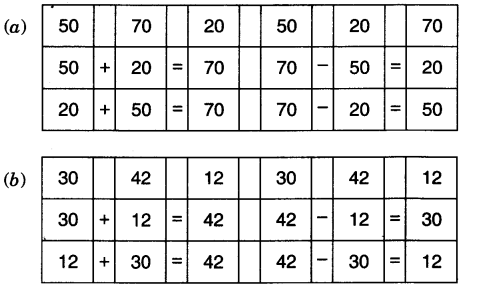Students can use Maths Mela Class 3 Solutions Chapter 3 Double Century Question Answer to explore alternative problem-solving methods.
Class 3 Maths Chapter 3 Double Century Question Answer Solutions
Double Century Class 3 Maths Question Answer
Class 3 Maths Chapter 3 Solutions
The Story of our Numbers
Tens of thousands of years ago, people started counting. They wanted to keep records of their things. So they made marks on the walls of caves and on the barks of trees.
Over time, they kept records of their things by making groups of 5, 10, 20, and 60.
Thousands of years ago, the ancient Indians created a method for writing any number, however large, using only ten symbols: 0, 1, 2, 3, 4, 5, 6, 7, 8, 9. It was one of the most ingenious and creative inventions in human history. It made possible the invention of TVs, computers, mobile phones, and more. This method of writing numbers is now used everywhere in every country in the world.
A very important part of this invention was the introduction and use of the symbol “0” to mean “nothing”. It is the number 0 that really made this system of writing numerals work!
Over the next few months, we will learn how to write all numbers, however large, using just these ten symbols.
Let us Do
Question 1.
Look at the picture. Estimate and write the number of each of the following objects.

a. Oranges : …………..
b. Bangles : ………….
c. Laddoos : …………
d. Barfi : ……………
e. Bindis : ……………
f. Bananas : …………………
Answer:
Number of each of the following objects:
(a) Oranges : 22
(b) Bangles : 75
(c) Laddoos : 28
(d) Barfi : 22
(e) Bindis : 80
(f) Bananas : 36
Let us Play
Fill the missing numbers on the board.

Answer the following on the basis of the Snakes and Ladders board:
Question 1.
Which number will you reach if you take the ladder from 13? …………….
Answer:
50
Question 2.
If you are on the snake at number 25, which number will you reach? …………
Answer:
2
![]()
Question 3.
You are standing on 96. Which number on the die will take you to the snake’s mouth? ………
Answer:
3
Question 4.
Show the number written on the tail of the longest snake using bundles and loose sticks. …………..
Answer:
![]()
Let us Think

These beads are also 100 in number.
Answer:

Let us Do
Question 1.
Fill in the blanks.

Bholu made 100 by jumping on 65 and jumped 35 more.

Make 100 by different jumps on this number line.

Answer:
80 and 20 makes 1oo
and 50 makes 100
Jump on the number line
Bholu jumping on 55 and then 45 more make 100

Question 2.
Use matchstick bundles and a ginladi to make 100 in different ways. Fill the table below.

Answer:
| 60 and 40 makes 100 | 45 and 55 makes 100 |
| 75 and 25 makes 100 | 15 and 85 makes 100 |
| 80 and 20 makes 100 | 10 and 90 makes 100 |
![]()
Question 3.
Write numbers in the blank spaces inside the flower petals so that the numbers in each petal add up to 1oo.

Answer:

Let us Explore
How many are 100?
Question 1.
Open a full box of matchsticks.
• Estimate the number of matchsticks in the box …………..

• Count the number of matchsticks in the box: ……………..
• How close was your estimate?
• How many boxes of matchsticks will 100 matchsticks? ……… boxes.
Answer:
• Estimate the number of matchsticks in the box: 30
• Count the number of matchsticks in the box: 25
• How close was your estimate? Nearly
• How many boxes of matchsticks will get the total close to 1oo matchsticks? 4 boxes.
Question 2.
Take a handful of seeds like kidney beans, chickpeas, etc.
• Estimate the number of seeds you have in your hand …………..

• Count the number of seeds in your hand: ………….
• How many handfuls of seeds will get the total close to 100 seeds? ……… handfuls.
Answer:
• Estimate the number of seeds you have in your hand: 10
• Count the number of seeds in your hand: 14
• How many handfuls of seeds will get the total close to 1oo seeds? 7 handfuls.

Answer:
• 100 and 3 makes One hundred Three 103
• 100 and 4 makes One hundred Four 104
• 100 and 5 makes One hundred Five 105
• 100 and 6 makes One hundred Six 106
• 100 and 7 makes One hundred Seven 107
• 100 and 8 makes One hundred Eight 108
• 100 and 9 makes One hundred Nine 109
• Fill in the blanks spaces on the number line given at the edge of the page.

Answer:

Let us Do
Question 1.
Let’s continue making numbers above 1oo using matchstick bundles and loose sticks.
In the table given below, identify the bundles and loose sticks and write the corresponding numbers.

Answer:

• Extend this table in your notebook till 150. Do you observe something common in all the numbers?
Answer:
Do yourself.
• Match the numbers with the correct bundles and loose sticks.

Answer:

Oh! Talking Pot is back. It will say one more than whatever you say.

Fill the blank spaces on the number line

Answer:

Show the following numbers on the number line below.


Question 1.
Place an arrow on 125.
Answer:
![]()
![]()
Question 2.
Make a tree on 112.
Answer:

Question 3.
Make a smiley on 149.
Answer:

Question 4.
Put a cross ![]() on 137.
on 137.
Answer:

Let us Play

Play this game in two teams. One team will show a number using clap, snap and pat and the other team will guess it.
Example: Clap – Snap Snap – Pat Pat Pat means 123 (One hundred and twenty three)
Let’s now count beyond 150.

Answer:

• Extend this table till 200 in your notebook. How much is 200?
Answer:






Let us Do at Home
• write the numbers in order on the stones.

Answer:


Let us Do
Jumping Game
Question 1.
Draw jumps of 5 on the number line and write the numbers on the number line in the given spaces.

Answer:

![]()
Question 2.
Continue jumps of 20 and write the missing numbers on the given number line.

Answer:

Question 3.
Fill in the table.

Answer:

Question 4.
Show at least two different ways of making the following numbers.
a. Use matchstick bundles to make 125.
Answer:

b. Make 145 using a ginladi.
Answer:

c. Make 170 on a number line.
Answer:

Question 5.
Fill in the empty boxes appropriately.

Answer:

Question 6.
Mark the following numbers on the number line.
a. 109, 112, 124, 134, 146

Answer:

b. 155, 163, 178, 189, 198

Answer:

c. 125, 142, 153, 174, 199

Answer:

NCERT Solutions for Class 3 Mathematics Chapter 3 Give and Take (Old Syllabus)
1.Try these on Kittu’s Home.
(a)10 less than 34 is———–
(b) 53 – 20 =———–
(c) 11 more than 31 is ———–
(d) 11 less than 66 is———–
(e) 62 + 13 =———–
(f) 23 less than 89 is———–
(g) 10 and 40 more is———–
(h) 9 added to 28 gives———–
(i)The sum of 9 and 44 is———–
(j) Reducing 98 by 34 gives———–
(k) 4 and 37 more is———–
(l) Take 35 away from 83. We get———–
Ans. (a)24 (b)33 (c)42 (d)55 (e)75 (f)66 (g)50 (h)37 (i)53 (j)64 (k)41 (l)48
How Many Bulbs?
1.A shopkeeper Rafi had 153 candles. Paras gave him 237 more candles. How many candles does Rafi have now?
Ans.
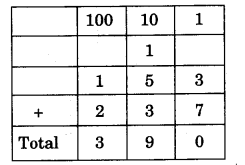
(A)A train compartment is carrying 132 people. Another compartment is carry¬ing 129 people. In all, how many people are there in both the compartments?
Ans.

Thus, there are 261 people in all.
(B) Shanu found 138 pebbles. Karim found 44 pebbles. How many pebbles did they find in all?
Ans.
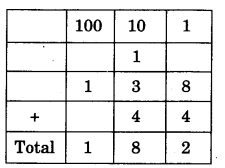
Thus, total number of pebbles are 182.
(C) A teacher kept a note of which fruits students like in her school. This is .what she found:

2. Find out:
(a) How many students in the school like oranges?
(b) How many students in the school like mangoes?
(c) Altogether, how many students are there in the school?
(d) Is the number of girls more than 350 or less than 350?
Ans. On completing the table, we have

(a)Number of students who like oranges = 136 + 128 = 264
(b)Number of students who like mangoes = 240 + 243 = 483
(c)Number of students in the school = 376 + 371 = 747
(d)Number of girls = 136 + 240 = 376 which is’more than 350.
Practice Time

Mind Train Game
1.Work out four different ways to write the numbers. If you add all the numbers in the first box, you will always get 59.
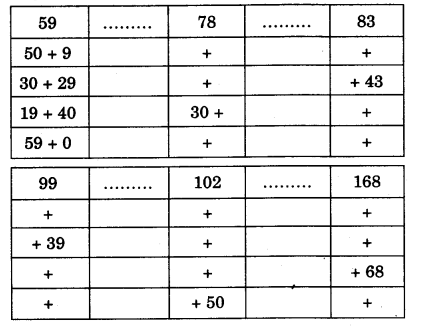
Ans.
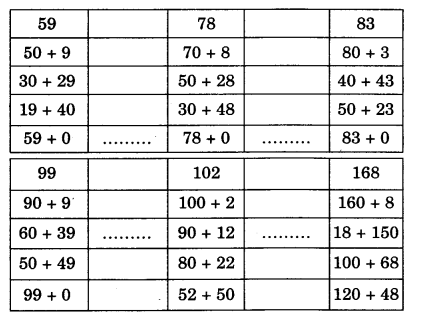
Can you solve this puzzle? Write the numbers 1, 2, 3, 4, 5, 6 in the circles, so that the sum of the numbers on each side of the figure is 12.
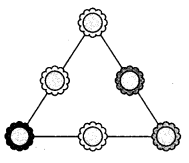
2.Find Mithoo’s bag.
Do all the sums mentally.
(a)75 + 20 = 95 (b) 90 + 60 = 150
(c)25 + 30 + 3 ——– (d) 9 + 40 + 31 ——–
(e)500 + 200——– (f) 400 + 350 ——–
(8)670 + 120——– (h) 380 + 210——–
(i)205 + 650 ——– (j) 128 + 600 ——–
(k)150 + 69 ——– (l) 37 + 46 + 3——–
Find Mithoo’s bag and check your answers. Draw a line through the numbers which are answers written in the boxes above.
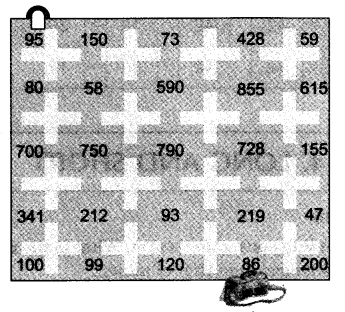
Ans. (c) 58 (d) 80 (e) 700 (/) 750 (g) 790 (h) 590 (i) 855 (j) 728 (k) 219 (l) 86.
Card Game
1.You can also play it. Here are the cards for you. Work out the combination. Place the cards in the right boxes.
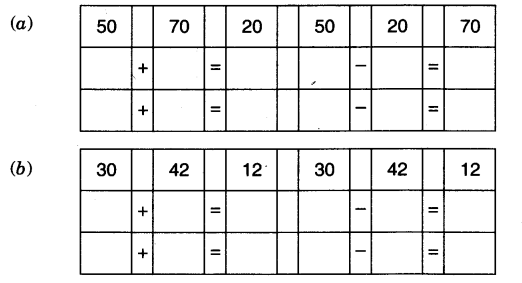
Ans.
